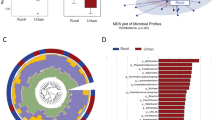Abstract
Background:
Analyzing faecal sterol concentrations in humans, subjects with a strongly decreased faecal cholesterol conversion were identified. The reasons and outcomes of this phenomenon have not been sufficiently investigated because of the complexity of the host–microflora interactions.
Subjects/Methods:
To evaluate differences between cholesterol high and low converters, the sterol excretion and faeces attributes of 320 healthy subjects (213 women, 107 men) were analyzed. Two different cut-off levels classifying cholesterol high and low converters were tested (level 1: conversion rate <30%; level 2: 50th percentile).
Results:
In both test models the faeces attributes differ significantly in a lower pH value and a lower faecal dry matter of the low converters in comparison with the high converters.
Conclusions:
These findings in faeces may reflect the conditions in the colon and can be a reason for the decreased bacterial growth and/or activity of cholesterol-reducing bacteria in the colonic microflora.
This is a preview of subscription content, access via your institution
Access options
Subscribe to this journal
Receive 12 print issues and online access
$259.00 per year
only $21.58 per issue
Buy this article
- Purchase on Springer Link
- Instant access to full article PDF
Prices may be subject to local taxes which are calculated during checkout

Similar content being viewed by others
References
Benno P, Midtvedt K, Alam M, Collinder E, Norin E, Midtvedt T (2005). Examination of intestinal conversion of cholesterol to coprostanol in 633 healthy subjects reveals an age- and sex-dependent pattern. Microb Ecol Health Dis 17, 200–204.
Ditscheid B, Keller S, Jahreis G (2005). Cholesterol metabolism is affected by calcium phosphate supplementation in humans. J Nutr 135, 1678–1682.
Ditscheid B, Keller S, Jahreis G (2009). Faecal steroid excretion in humans is affected by calcium supplementation and shows gender-specific differences. Eur J Nutr 48, 22–30.
Keller S, Gimmler F, Jahreis G (2008). Octacosanol administration to humans decreases neutral sterol and bile acid concentration in feces. Lipids 43, 109–115.
Keller S, Jahreis G (2004). Determination of underivatised sterols and bile acid trimethyl silyl ether methyl esters by gas chromatography-mass spectrometry-single ion monitoring in faeces. J Chrom B 813, 199–207.
Norin E (2008). Intestinal cholesterol conversion in adults and elderly from four different european countries. Ann Nutr Metab 52 (Suppl 1), 12–14.
Watanuki M, Goto Y, Wada Y (1983). Influence of gastrointestinal flora on the lipid metabolism of the host rats. In: T Mitsuoka (ed.) Chonai Furora to Eiyo (Intestinal Flora and Nutrition). Proceedings of the 3rd Riken Intestinal Flora Symposium. Japan Scientific Society Press: Tokyo. pp 107–120.
Wilkins TD, Hackman AS (1974). Two patterns of neutral steroid conversion in the feces of normal North Americans. Canc Res 34, 2250–2254.
Acknowledgements
I thank the staff of the Department of Nutritional Physiology for the excellent support in data gathering.
Author information
Authors and Affiliations
Corresponding author
Rights and permissions
About this article
Cite this article
Keller, S. Faecal varieties between high- and low-converters of cholesterol. Eur J Clin Nutr 64, 227–229 (2010). https://doi.org/10.1038/ejcn.2009.118
Received:
Revised:
Accepted:
Published:
Issue Date:
DOI: https://doi.org/10.1038/ejcn.2009.118



